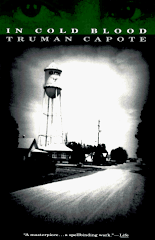1. Holcomb, Kansas, appeared to Capote as the very embodiment of traditional American ideas. Discuss the importance of the setting in Holcomb. What does the novel reveal about the town? How does the gossip surrounding the crime reflect underlying truths about Holcomb and small town Kansas? Is the town a character or protagonist?
2. Capote wrote what he termed a non-fiction novel. The combination was intended to achieve historical accuracy but also use fictional devices to shed creative light on actual events. In what ways is In Cold Blood like a fiction novel? In what ways is it like journalism? Did Capote achieve his goal?
3. Capote also tried to be both documentary and literary in In Cold Blood. For example, describing Kansas: “The land is flat, and the views are awesomely extensive; horses, herds of cattle, a white cluster of grain elevators rising as gracefully as Greek temples are visible long before a traveler reaches them.” How does this influence the reader’s sympathies?
4. How is montage used in In Cold Blood? Capote used several points of view—third person through the narrator’s eyes, third person through Alvin Dewey’s eyes, third person through Perry Smith’s eyes. Does this shifting perspective hide what Capote thought of the crime or the people involved? Do the back-and-forth descriptions of events in Holcomb and the trial make the novel more vivid?
5. Because the Clutter family could not speak for themselves, Capote’s information about them was supplied by neighbors, friends and other people who knew the family. Capote got most of his information about the perpetrators of the crime directly from them. How does these shape readers’ opinions about the victims and about the criminals?
Tuesday, April 15, 2008
Subscribe to:
Posts (Atom)
